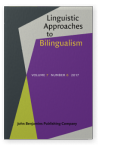Commentary
Beyond steady-state models of ultimate attainment
References
Bardovi-Harlig, K., & Stringer, D.
(
2010)
Variables in second language attrition: Advancing the state of the art.
Studies in Second Language Acquisition, 321, 1–45.


Chomsky, N.
(
1965)
Aspects of the theory of syntax. Cambridge, MA: MIT Press.

Chomsky, N.
(
1980)
On cognitive structures and their development: A reply to Piaget. In
M. Piatelli-Palmarini (Ed.),
Language and learning: The debate between Jean Piaget and Noam Chomsky (pp. 35–54). Cambridge, MA: Harvard University Press.

Chomsky, N.
(
1981)
Lectures on Government and Binding: The Pisa Lectures. Dordrecht: Foris.

Cook, V. J.
(Ed.) (
2003)
Effects of the second language on the first. Clevedon: Multilingual Matters.


Cook, V. J., & Newson, M.
(
2007, 3rd.ed.),
Chomsky’s Universal Grammar: An introduction. Malden, MA: Blackwell.

Hyams, N.
(
1986)
Language acquisition and the theory of parameters. Dordrecht: Reidel.


Ionin, T., Ko, H., & Wexler, K.
(
2004)
Article semantics in L2-acquisition: The role of specificity.
Language Acquisition, 121, 3–69.


Iverson, M.
(
2012)
Advanced language attrition of Spanish in contact with Brazilian Portuguese. Unpublished doctoral dissertation, University of Iowa.


Kecskes, I., & Papp, T.
(
2000)
Foreign language and mother tongue. Mahwah, NJ: Lawrence Erlbaum.


Lardiere, D.
(
2009)
Some thoughts on the contrastive analysis of features in second language acquisition.
Second Language Research, 251, 173–227.


Oh, J., Au, T. K., & Jun, S. -A.
(
2009)
The nature of childhood language memory: Korean adoptees learning Korean as adults. In
J. Chandlee,
M. Franchini,
S. Lord, &
G. -M. Rheiner (Eds.),
Proceedings of the 33rd Annual Boston University Conference on Language Development, (Vol. 21, pp. 391–397). Somerville, MA: Cascadilla Press.

Pascual y Cabo, D., & Rothman, J.
(
2012)
The (il)logical problem of heritage speaker bilingualism and incomplete acquisition.
Applied Linguistics, 331, 450–455.


Pierce, L. J., Klein, D., Chen, J-K., Delcenserie, A., & Genesee, F.
(
2014)
Mapping the unconscious maintenance of a lost first language.
Proceedings of the National Academy of Science (PNAS), 111(48), 17314–17319.


Putnam, M., & Sanchez, L.
Sorace, A.
(
2000)
Syntactic optionality in L2 acquisition.
Second Language Research, 161, 93–102.


Stringer, D.
(
2015)
Embedded wh-questions in L2 English in India: Inversion as a main clause phenomenon.
Studies in Second Language Acquisition, 371, 101–133.


Tsimpli, I. -M., Sorace, A., Heycock, C., & Filiaci, F.
(
2004)
First language attrition and syntactic subjects. A study of Greek and Italian near-native speakers of English.
International Journal of Bilingualism, 81, 157–177.


White, L.
(
2015)
Linguistic theory, Universal Grammar, and second language acquisition. In
B. VanPatten &
J. Williams (Eds.),
Theories in second language acquisition (2nd ed.) (pp. 34–53). New York: Routledge.

Cited by
Cited by 2 other publications
Stringer, David
2020.
Not all acquisition entails attrition: The persistence of syntax in the teeth of lexical breakdown.
Second Language Research 36:2
► pp. 225 ff.

Stringer, David
2021.
Commitment in L3 relationships: Sacred vows or polyamory?.
Second Language Research 37:3
► pp. 495 ff.

This list is based on CrossRef data as of 4 may 2024. Please note that it may not be complete. Sources presented here have been supplied by the respective publishers.
Any errors therein should be reported to them.
